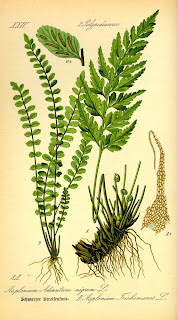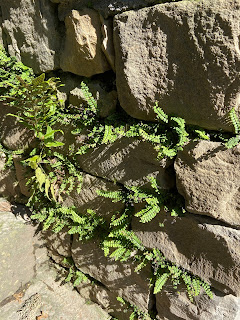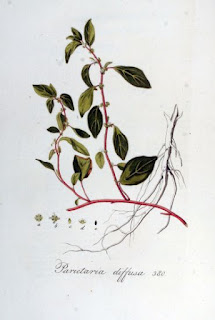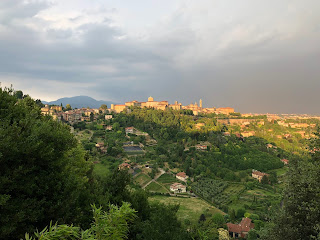Via Pelabrocco stirs to life with the first hints of people making their way to the upper city. We wake and dress for our run, preparing to join them. We make our way down four flights of stairs without meeting anyone. The 15th century building that today is our home was once a convent; we would have surely met a sister or two up at this hour of the morning if it still were.
We pass through the courtyard with grey stone columns and intricately decorated capitals, an iron gate with its reminder to always close it (
si raccomanda di chiudere sempre il cancello), and through a small wooden door – not all all appropriate for tall people – to reach the street.
The small wooden door is interesting. It is inset into a much larger green wood door referred to as a
portone – a door (
porta) of large size (-
one). Our palazzo’s
portone is closed and locked every night. We are a small medieval fortress. Filippo, our sixty-five-year-old neighbor, has the job of opening and closing the door. He lives next to us with his mother in two rooms: a bedroom and kitchen. Filippo sleeps in the kitchen. The task of opening and closing the door is a welcome relief from the cramped quarters he shares with his ailing mom. He smokes a cigarette or two as he lumbers up and down the three flights of stairs.
Filippo’s mom does not let him smoke inside the apartment. When we meet her, feeling her way to the bathroom, which is outside their apartment and past our front door, she says of her son: “
Fuma come un turco!” – he smokes like a chimney. Then, she tells us about her kidney problems and the exact amount of water she drinks each day. If time permits, she recounts the time she fell down the attic (
solaio) stairs.
Coming or going, we often find ourselves face to face with Filippo sitting on the steps to the attic smoking a cigarette, his nicotine-stained moustache and beard visible in the dim light. Perhaps, it’s the same spot his mom ended up in after her fall down said stairs.
Exiting on Pelabrocco, we encounter a
Piaggio Ape as it winds and whines its way up Pelabrocco’s herring bone brick pavement to bring supplies to the upper city. Maybe there is something in the three-wheeled Ape truck we’ll be eating later when we walk up for lunch?
Twenty steps from our medieval fortress and we bid good morning to Flaminia hanging out her first story window and greet Mario who hurries by on his way to his daughter’s house to wake his grandkids. In a few minutes time, we will run by Mario’s wife Rocchi, already out walking with friends on the Venetian walls surrounding the upper city.
Left: View of Via Pelabrocco. Center left: The big green palazzo door. Center: Columns in the courtyard of a palazzo on via Pelabrocco. Center right: A Piaggio Ape. Right: Viccolo Pelabrocco, not to be confused with Via Pelabrocco.
Names
Via Pelabrocco is a small stub of a street. At one time, it used to connect the lower city to the upper city but that was before the building of the Venetian walls forever reshaped the landscape of Bergamo and created a bipolar city: the upper city (Città Alta) and the lower city (Città Bassa). The walls were built between 1561 – 1591 by the Republic of Venice to defend their empire. From all accounts, the construction of the walls was a traumatic change that required the destruction of hundreds of buildings.
Before the walls, Via Pelabrocco connected to Via Osmano, and was the principal entry into the upper city for travelers arriving from Venice and other points east of Bergamo. After the walls were completed, Pelabrocco became a lonely spur, a shortcut for cars looking to avoid the principal road Viale Vittorio Emanuele II, which originates from the train station and was designed to bring emperors and kings to the upper city in a stately fashion. In fact, that street from the station to the start of the upper city changes names no less than three times. It starts off as Viale Papa Giovanni XXIII, changes to Viale Roma, and finally to Vittorio Emanuele II. The last stretch honors the first king of the Kingdom of Italy (1861 – 1946). On our morning runs, we pass from Pelabrocco to Vittorio Emanuele II to run the last couple hundred meters of the viale and enter the upper city through the Sant’Agostino gate.
Many times, huddled with the locals over a newspaper and espresso macchiato in Caffé Papavero, we were regaled with stories of how the name Via Pelabrocco derived from the steepness of the street: “pela” derived from the verb pelare – to peel or skin and “broc” dialect for something worn out or without value, related possibly to the word brocco – meaning a rundown horse. Entertaining stories but probably not true we decided when we consulted a book about the history of the neighborhood. The book stated that in the 1300s a certain Corrado de’ Pelabrocchi lived in the area and lent his name to the street.

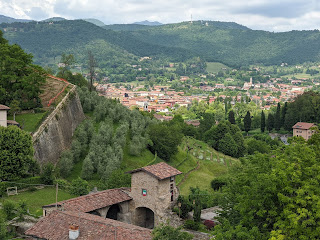

Left: Bergamo - Porta San Giacomo. Center: Bergamo - Porta San Lorenzo. Right: The Lion of San Marco - symbol of Venice - over Porta Sant'Alessandro.
Portals
After passing through the Porta Sant’Agostino, we turn a left and run along the Viale delle Mura, literally “the boulevard of the wall”.
There are four ways or gates to enter the upper city: Sant’Agostino, San Giacomo, Sant’Alessandro, and San Lorenzo. Each has its unique history and purpose. Sant’Agostino was the entrance from travelers from Venice and points east, San Giacomo for travelers from Milan and points south, San Alessandro for travelers from Como and points west, and San Lorenzo for travelers from the Val Brembana and points north.
Between the four gates, what we call just the wall (le mura) is composed of different architectural fortification elements like bastions (baluardi) and ramparts (terrapieni). After the construction of the wall and during the end of the 16th century and beginning of the 17th century, these areas would have been where garrisons (guarnigioni) trained and kept watch for an attach that never came. When Bergamo came under Austrian rule, the areas were turned into parks. Today, the troops are long gone replaced by stately horse chestnut trees (Aesculus hippocastanum) standing in formation, their artillery being occasional spiky conkers dropped on the unsuspecting.
We climb steadily, running due southwest to reach Porta San Giacomo, the upper city gate that appears on all postcards of Bergamo. This elegant white marble and temple-like façade of this gate was in fact the first gate we used to enter the city back in 2015, a foggy night two days after the Paris attacks. In homage, the gate was lit up that night with the colors of the French flag. Today, we just run by Porta San Giacomo and stay in the upper city.
This is the hardest part of the run. At 1.5 km into the run and we’ve climbed steadily uphill with no relief. At our farthest point south of the run, just past Porta San Giacomo we find ourselves on the San Giacomo bastion. We turn sharply northwest and continue on top of the Venetian wall while the pre-Venetian medieval city walls are visible to our right.
So far, our run traces the exact outline of the Venetian wall.
On the San Giovanni bastion we sharply turn northeast and run toward the part of the upper city called Colle Aperto, a major meeting point for Bergamaschi and tourists. The bus to the lower city and destinations beyond like the airport terminate in Colle Aperto. La Marianna where la stacciatella gelato flavor was invented in 1961 is here as well.
Skirting the outdoor seating a La Marianna we catch a glimpse a few early birds at breakfast with their croissants (cornetti) and coffee just before we duck through the Porta Sant’Alessandro. We are outside the upper city again on the north side of the upper city. We will be back inside the upper city later this run, but for now, we our heading northwest to the hills behind Bergamo.


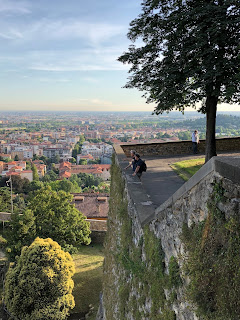

Left: Marching Horse Chestnut trees along Piattaforma di Sant'Andrea. Center left: An ivy swan along Viale delle Mura. Center right: Edge of Piattaforma di Sant'Andrea. Right: A sundial on Baluardo San Giovanni.
Universe
Many years ago, we used to run through the posh residential area of San Marino in Los Angeles county. We lived in the adjacent Pasadena, but for a run we always headed to San Marino. The winding tree-lined streets attracted us and provided a relief from the grid layout of Pasadena. During our runs we would fantasize about which Mission Revival house owner was just waiting to adopt for us. Of course, we would accept the adoption request only if the house had curb appeal. Edwin Hubble (1889 – 1953) – who helped us understand our expanding universe – lived in just such a house in San Marino that I am sure we ran by many times.
Thirty years later and we find ourselves running through a similar neighborhood in many respects. This time we are on the country lanes behind Bergamo’s upper city, on Via Sudorno and Via Torni. These lanes follow the scallop-like contours of the hills behind Bergamo, never gaining and losing much altitude, near perfect isoclines on a map.
Via Sudorno and Via Torni are desirable locations to live as they enjoy southern exposures and uninterrupted views of the Po Valley (la pianura padana). On a clear day, the skyscrapers of Milan are visible. Between villas, ornamental and working gardens squeeze together economically, some gardens so vertically inclined that those who suffer vertigo should be forewarned.
This manmade landscape is a feast for the eyes. Everything in place, everything orderly and lots of luxurious green. We find ourselves thinking about which villa we would accept if offered to us. Being older now, adoption is out of the question.
Besides the scenic aspect of Via Sudorno and Via Torni, these lanes have little car traffic which makes for a relaxing walking destination. On weekdays and especially weekends, walkers, runners, and bikers easily outnumber cars.


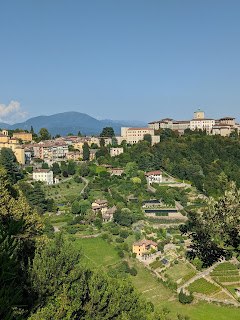

Left: A caper plant on a wall along Via Sudorno. Center left: A bougainvillea on Via Sudorno. Center right: A view of the gardens below Via Sudorno. Right: The skeleton paintings of Santa Grata.
Several sources give the name Sudorno as medieval in origin and referring to the Roman cult of Saturn. Saturn is among many things, the god of generation (think sowing seed) and agriculture. Given the Via Sudorno’s fortunate sun exposure and existing lush greenery, we can very well imagine the connection as a place that was once Bergamo’s vegetable garden if not vineyard. In fact, just steps off Via Sudorno, the church Santa Grata Inter Vites clings to the side of the hill, its name hinting at the past: inter vites or “among the vines”.
Inside the Santa Grata church, quirky danse macabre paintings called Scene di scheletri viventi (“Living skeletons scenes”) painted by the artist Paolo Bonomini in the XIX Century, are hidden behind the altar. The danse macabre represents an allegory typical of the Late Middle Ages commenting on the universality of death; no one escapes no matter who you are. When the paintings were created, they were considered edgy artwork, as the skeletons resembled some actual people living in the neighborhood: a carpenter, two praying friars, a couple of newlyweds, a Cisalpine Republic tambourine and even the artist himself, next to his wife.
For Sudorno’s etymology however, we prefer our own misguided version: the name surely derives from the verb sudare – to sweat – which is what we are usually doing when we are on this lane.
The peripatetic friar Giordano Bruno (1548 – 1600) passed through Bergamo in the summer of 1578. Bruno put forward many revolutionary ideas (at the time) such that the stars were distant suns surrounded by their own planets and that the universe is infinite with no center. Surely, he would have spent time in the upper city and might even had taken a stroll on via Sudorno discussing his ideas with the locals and stopping at Santa Grata Inter Vites?
Bruno was burned at the stake for heresy, not for his astronomical views but rather for his philosophical and religious views. On the contrary, Galileo Galilei (1564 – 1642) got in trouble with the church specifically for his heretical ideas about our universe that were spot on. (The church eventually agreed with Galileo in 1992, 359 years later.)
Galileo was under house arrest for the last 11 years of his life in a villa in Arcetri, a neighborhood in the hills south of Florence. These hills were our preferred running spot in 2007 – 2008 when we lived in in a small house in the Oltrarno (south side of the Arno River) in Florence. The aspects of Arcetri that attracted us – villas, vineyards, towering cypresses, and winding country lanes – are all present in the hills behind Bergamo. The universe doubles back on itself.
Left: The start of Via Torni. Center left: A wisteria vine frames a doorway on Via Torni. Center right: A floral design detail on Via Torni. View over Monastero Astino.
Help
An early morning in June and we are running on Via Sudorno. The bells of the church Santa Grata Inter Vites ring and other distant church bells answer. We run by the Istituto Suore Canossiane, a nursing home (
casa di riposo) where sisters help the elderly live out their last days. If we are lucky, we might catch a sister opening shutters as we run by. For sure we will shout
Buongiorno! to get a smile out of her.
Past the Canossiane sisters, past walls of bougainvillea (
Bougainvillea), trumpet vines (
Campis radicans), pennywort (
Cymbalaria muralis), pellitory of the wall (
Parietaria officinalis), star jasmine (
Trachelospermum jasminoides), passion fruit (
Passiflora) and an occasional caper plant (
Capparis spinosa) the road begins to narrow to the point where we become shoulder to shoulder with other walkers. On an early weekday morning like this, those other walkers are women heading in the same direction, and judging by their dress and comportment, they are headed to one of the villas on via Sudorno to help; they are staff. The ones we typically pass on Sudorno are South American judging by complexion and snippets of speech we overhear. They are caring for a parents and grandparents in one of the Via Sudorno villas. Our friend Lola says that Bolivians make good care givers and Ukrainians make good housekeepers. Regardless of what they do, these women are an integral part of the social fabric.
If school is out, the women walk with a young child or two in tow. The child is told to sit quiet in some part of the villa and stay out of the way as mom does her job.
We are often asked if we have help, that is someone who cleans our apartment or does our laundry and ironing. Our humble three-room apartment does not require outside help, or so we think. To the question we answer sheepishly “no” and explain that our apartment is small and easy to take care of, and we don’t mind doing our own laundry. Our formative years absorbing cultural habits were in a solidly American middle-class context where no one we knew hired help for cleaning or laundry or taking care of parents.
In Italy, labor is relatively cheaper and families from the middle class and up often have help like our early morning Sudorno walkers. Some of the Sudorno villas may very well have been in a family for generations. The size of the villa is not the choosing of the current occupants but getting help to maintain it is and is economical. As well, many generations of family live together in said villa and a caretaker for parents or grandparents makes sense. Therefore, our explanations as sincere as they are to our friends as to why we don’t hire help, never quite sound convincing to Italians.
Left: The start of Via Sudorno. Center left: A doorway on Via Sudorno. Center left: View from Via Sudorno toward the Upper City. Right: A narrow part of Via Sudorno.
Fortune
The run northwest along Via Sudorno and then Via Torni is mostly flat staying at constant 380 m about sea level. Unexpectedly (but typically Italian), the name of Via Torni changes at a sharp turn in the road. The name becomes Via G. Marieni honoring General Giovanni Marieni (1858 – 1933), an important figure in the modernization of the Italian air force in World War I. The lane wraps around his ancestral family property sitting at the end of a small ridge. The general is buried nearby at the Tempo dei Caduti that we passed 10 minutes earlier on the run at the start of Via Torni. The hills Via Sudorno and Via Torni cut through are woven with a thousand stories like this.
Running along Via Marieni, it is as if we have left Bergamo far behind and entered a bucolic paradise of country estates. On any given day in Spring, we hear the bawl of a calf or bleat of a lamb coming from behind the walls of the estates. Just part of the Via Marieni soundtrack. One day we run by goats bleating and staring down on us, perched on a grassy knoll on the general's ancestral property. Are these the general’s goats?
And all along the way, fresh mule and horse droppings remind us we are not the only ones up this morning.
The song "Fortune Presents Gifts Not According to the Book" from the music group Dead Can Dance appeared on their Aion release. The song includes the following lines "When you expect whistles it's flutes / When you expect flutes it's whistles." The song reminds us of the serendipitous route that brought us to Bergamo, running on this road at this moment, a product of fortune.
Via Sudorno to Via Torni to Via Marieni is an easy run, mostly flat. As Marieni ends, we start a long slow climb on Via San Sebastiano. We distract ourselves from the climb with views out over the Brembo River valley as it exits the confines of Valle Brembana. In the distance, the pastures topping Monte Linzone catch the eye looking like a medieval tonsure.
Via San Sebastiano takes you up (in Italian street logic) naturally to the Chiesetta di San Sebastiano. A small fresco of the arrow-pierced saint is above the door. Somehow, the saint keeps a beatific look through it all, a study in sprezzatura. Saint Sebastian is popular among athletes which is no surprise as the saint is almost always depicted with a nice body and minimal clothing. Saint Sebastian is the perfect metaphor for our June man, not May or July. By way of comparison, Saint Jerome is an August man.
At the church, we turn left on to Via Colle dei Roccoli and continue our run upwards. The name of this street recalls a landscape feature particular to Lombardy: a roccolo. A roccolo is a big trap for birds, usually smaller migratory birds. You might say it is a bird snare, but that's a bit of an understatement to describe these often large and intricate structures, built and maintained over hundreds of years. They are more like architettura vegetale. Roccoli are built different ways, but commonly are in a circular shape constructed of trees, shrubs, and other materials like wire, poles, and netting. Roccoli are almost always located on a hilltop in the path of birds migrating across the Alps.
The first roccolo is said to have been created by Bergamaschi priests escaping the plague of the XIV century. The priests headed up into the mountains, but once there needed to eat and so the story goes that they invented the roccolo to catch birds to eat.
One quirky reminder of roccoli – although it escapes most tourists to Bergamo – is the insipid dessert called “polenta and birds” (polenta e osei). The dessert, invented in the early 19th century, packages layers of yellow sponge cake, marzipan, chocolate, and rum. The package is shaped to look like a heap of polenta with little chocolate birds on top. The concoction recalls how the birds caught in the roccoli were typical eaten: over polenta.
Running on Via Colle dei Roccoli today, traces of roccoli are hard to see as many fell into disuse when the hunting of birds with roccoli was outlawed. Remaining roccoli are either preserved for their architectural and cultural significance or used in scientific studies, all to the good fortune of the birds. One good remaining example is nearby on Via Castagneta, on the hills above Trattoria Parietti.




Left: A horse on Via Orsarola. Center left: Goats along Via Marieni. Center right: View northwest from Via San Sebastiano toward Chiesa Parrocchiale di San Rocco Confessore (Fontana). Right: San Sebastiano mural above the entrance to the Chiesetta di San Sebastiano.
Happiness
On Via Orsarola, we reach the highest point in the run at approximately 460 m above sea level. This high point is labeled on Google Maps as Infinito and it offers beautiful views south. From here the path home is more or less downhill. There is sense of accomplishment and happiness. Gravity will assist the rest of the way and all we need to do is pick up our feet to let that happen.
One morning, we hear the clip-clop of a horse behind us as we struggle up Via Orsarola. The horse catches up to us at the high point. A beautiful Arabian struts by with rider on a cell phone. The unexpected encounter with the majestic creature leaves us happy.
We follow Via Orsarola down to Via Vetta (literally “top street”) to Via Felice Cavagnis. This street is named for Felice Cavagnis (1841 –1906), an Italian canon lawyer and Cardinal, born in Valle Brembana, in the Diocese of Bergamo. His first name derives from the Roman cognomen felix, which meant “lucky”, “successful”, “fruitful”, and by extension, “happy” and “contented”. Felice in Italian means happy or cheerful.
Did the happy cardinal live on this street named after him? We do not know. One of our friends in Bergamo, Lola, did live on Via Felice Cavagnis. When we run by her old house, we note any changes and file them away as a topic for one our next lunch dates with her. Lola was one of the first people we met in Bergamo. On day three after landing in the city – excited and wide-eyed to explore – Lola came walking down Via Pignolo and up to us and said: “You must not be from here. You are smiling too much.” We all laughed and knew we would be good friends after that.
We are happy now on the last half of our run because it is in the leafy, shady part of the hills behind Città Alta. This part faces northeast and is one of our favorite views toward the Bergamasque pre-alps. If the Via Sudorno and Via Torni part of the run, south facing, was all manicured gardens, this part of the run, north facing, is rolling hills and forest.
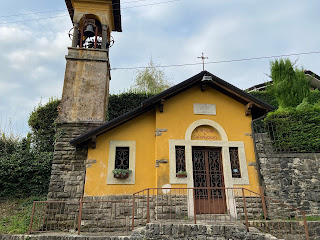


Left: B. Vergine Di Caravaggio on Via Felice Cavagnis. Center: A private roccolo off of Via Cavagnis. Right: View from View Via Monte Bastia at the beginning of Felice Cavagnis looking north.



Left: View from Via Vetta toward Sorisole. Right: View south from Via Orsarola on a cloudy morning. Right: View south from Via Orsarola on a sunny day.
Secrets
We are on the last leg of our run. Via Felice Cavagnis drops us on to a road named Via Costantino Beltrami, named for the Bergamo-born Giacomo Costantino Beltrami (1779 – 1855). Beltrami was an Italian jurist, author, and explorer who uncovered secrets of still a still unexplored America of the early 19th century. He is known for claiming to have discovered the headwaters of the Mississippi River in 1823.
A famous painting of Beltrami shows him paddling a boat on a river (presumably the Mississippi) in his finest dress. He could be a stand in for Saint Sebastian in his looks except his has on too many clothes and no arrows stuck in him. Beltrami’s apparent peaceful nature and curiosity led to good relations with Native Americans he encountered, and he even published an English-Sioux dictionary, a first of its kind. Beltrami County in Minnesota is named for this Bergamo hometown hero.
Running on Via Beltrami we find ourselves suddenly back inside of Città Alta. How did that happen? It turns out that the walls of Bergamo’s Città Alta are not exactly intact: there is a breach! A piece of the wall was demolished in the early 19th century to connect the Castagneta neighborhood with the upper city. We in fact run through where there was once was a wall. A stone plaque marks the location and commemorates the company, Angelini, who undertook the demolition and the date, 1907 – 1908.
Of the Venetian wall surrounding Città Alta and it four principal gates, there is another curious fact to consider: the existence of a secret fifth entrance, today unused. The fifth entrance is called the Porta del Soccorso (“Emergency Door”) and can still be seen on Via Sotto Mura di Sant’Alessandro, a short cut for avoiding part of Via Felice Cavagnis. The door could be used to escape from the city or a way to make a surprise ambush.
Via Beltrami brings us back to Colle Aperto, the open-air terrace of Città Alta overlooking a steep green ravine that ends at the only upper city gate we don’t run by or through, Porta San Lorenzo. This gate was in fact the first to be built.
Colle Aperto is even more alive than when we passed through 35 minutes earlier on the first leg of our run. People enjoy their espresso (often referred to a caffè liscio) over a paper at the popular La Marianna. A nearby newsstand (edicola) always has one or two people waiting at this time of the day. Italians are nothing if not avid readers of newspapers – lovers of words – and even during the lockdown, newsstands were considered essential services and remained open. A significant part of RaiNews news program that we tune into each morning is dedicated to reading newspaper headlines. It’s a great learning technique.
On Colle Aperto, the morning meeting of garbage trucks is in progress nearby La Marianna. A smaller electric truck – perfect for the narrow cobblestone streets of the upper city, transfers its haul to the bigger mothership truck. The trashman in bright orange vests chat and laugh in a thick Bergamasco accent that, while defying comprehension, is pleasing to hear.
We run along the terrace with a view of Porta San Lorenzo. The benches are filled with the elderly (anziani) taking in the scene and watching us run by: us as the morning news. Suddenly the road drops and we pass through a tunnel through a three-story building building. This is the Porta del Pantano inferiore, wide enough for one car and maybe a runner like us if we flatten ourselves against the wall.




Left: The start of Via del Vàgine. Center left: Sign describing Fontana del Vàgine. Center right: Porta del Pantano inferiore. Right: Piazza Mascheroni.
The Porta del Pantano passage was a gate into the medieval upper city used centuries before the Venetian walls were build. The etymology of portano refers to "swamp", as this was an unhealthy area documented in medieval times, if not in Roman times. Unhealthy or not, you still had to pay to pass through the gate.
After passing through the Porta del Pantano, we run alongside the Piazza Mascheroni named for the Bergamasco mathematician and academic Lorenzo Mascheroni (1750 - 1800). Besides numerous streets, piazze, and schools bearing his name, his name is also attached to the Euler–Mascheroni constant, a mathematical constant recurring in analysis and number theory.
We leave the mysteries of Mascheroni mathematics and continue down Via della Boccola, the backside of the upper city. In keeping with the swamp theme, this side of town always had a bit of reputation and was known to be frequented by prostitutes. The ladies – it is reported – could only use the fountains (no indoor plumbing back then) in this part of town. Also, Via della Boccola was commonly transited by soldiers and sometime clients of the nearby brothel.
We’ve been on more than one tour of Città Alta and looking down from La Rocca had our attentions directed to a certain palazzo on Via San Lorenzo with an unusual number of ornate chimneys. It is said that this was the brothel of Città Alta. More than decorative, the chimneys served a function: if smoke exited from a chimney, that lady was occupied. This palazzo is only a stone throw from Via della Boccola.
Via della Boccola descends steeply and curves left with views to Porta San Lorenzo. Just before the descent and curve a curiously named street, Via del Vàgine, branches off and runs by the ex-prison. (Here, the accent is written to show that this word is stressed in a different syllable than expected.) In Italian, vagina is vagìna with plural vagìne. (Here, the accents are added only for clarity and wouldn’t typically be written.) With the accent on the letter A, it’s a different word, a nonsense word that derives from a Council of Trent inspired change by city officials to avoid the embarrassing meaning. They shifted the stressed syllable. It is believed that the original name was Vagìne but the reasoning is not clear. It could have been a synecdoche for the brothel nearby. Or, it could have referred to the sheath of sword given that the Bergamo area was famous for sword production. Or still another etymology put forward: newborns were plunged in the nearby fountain and if they cried out (vagíto) they were of strong stock. Who knows? The backside of Bergamo’s Città Alta does not reveal its secrets that easily.



Left: A night scene at La Marianna in Colle Aperto with the big beech tree (Fagus sylvatica) lit up. Center: Twilight on Via Torni. Right: Sunrise over Bergamo lower city.
Unexpected
The last kilometer of our run takes us along Via della Fara. La Fara is a wedge-shaped park in front of the Ex Saint Agostino monastery. It was once a big ditch (
fosso) that got filled in when the Venetian walls were build. Today it is a popular open space for soccer and hanging out. The word
fara is Longobard in origin and refers to a settlement or piece of land. The Longobard’s were a Germanic population who ruled most of Italy from 568 to 774.
The 13th century Saint Agostino Monastery today is part of the University of Bergamo. The main church is oriented liturgically east-west. A small white statue of Saint Augustine sits high up on the austere brown façade. Saint Augustine faces toward the rest of Città Alta as if in defiance or perhaps looking to see if he can even see the rest of the city, which of course he can’t.
From a bird’s eye view of the Venetian walls, the inclusion of the monastery and its beautiful cloisters within the upper city walls is unexpected given that the heart of Città Alta, Piazza Vecchia, is about 1 km away. Top of the most prominent feature of Piazza Vecchia, the big belltower (
Il Campanone) isn’t even visible from Saint Agostino be it on on the ground or from Saint Augustine’s point of view.
It turns out that when the friars of Saint Agostino caught wind of the imminent destruction of their home for the building of wall in the 16th century, they tried threats of excommunication but eventually found it more useful to raise money and pay to not be destroyed. Besides the money, the monastery was preserved by the fact that the original planned route of the wall (that would have cut off the monastery) was over a steep hill, which proved to be a difficult construction feat. In the end the Venetian authorities decided it was easier to lengthen the wall to include the monastery and avoid the hill altogether so today we have Saint Agostino monastery as part of Città Alta – even if it seems like it isn’t. As one history of the wall,
Le mura di Bergamo, put it: the authorities killed two birds with one stone (
pigliare due piccioni con una fava).
If the first part of the run along south and west along the walls was all about horse chestnut trees (
Aesculus hippocastanum), the run along Via della Fara is all about London Plane trees (
Plantanus x
acerifolia). This tree is thought to be a cross between the American Sycamore (
P. occidentalis) and the Oriental Plane (
P. orientalis). The bark of London Plane trees is often a psychedelic mix of exfoliating gray, green, and brown blotches. There is one plane tree in the bunch on Via della Fara that we run by that is a bit of
celebrity in Bergamo due to its unexpected tenacity to stay alive. The tree’s name is Plà. Plà’s trunk twists in a spiral and abruptly ends at 15 feet into a sort of stump at which point branches haphazardly sprout.
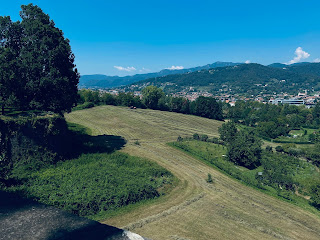
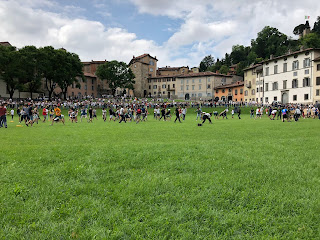

 Left: View north over Baluardo della Fara – mowed fields. Center left: End of school games on La Fara. Center right: The London Plane tree called Plà on Via della Fara. Right: Winter on Baluardo di Sant'Agostino.
Left: View north over Baluardo della Fara – mowed fields. Center left: End of school games on La Fara. Center right: The London Plane tree called Plà on Via della Fara. Right: Winter on Baluardo di Sant'Agostino.In April 2020, Italy entered into a slightly more relaxed version of the coronavirus lockdown. In this phase, we could resume our runs, which was a welcome relief to be able to go outside freely. As dutiful citizens, we brought our masks with us on runs. When we thought we might encounter another person, we put our masks on. When no one was around we took the masks off. Sometimes, we forgot and just ran with them on. We were surprised at unexpected chastising received from other runners and bikers in reaction to wearing masks while running. The urged us to take off our masks because we would suffocate from breathing our own carbon dioxide. Yes, the masks are hot and uncomfortable – especially running – but suffocation is not possible. “
Grazie” we would say and kept on running.
We were surprised to find ourselves in Bergamo in March 2020, unexpectedly at the first epicenter for coronavirus in Italy and Europe. The original coronavirus outbreak Italy may have started in the nearby town of Codogno, but Bergamo, the name of the city and the province is what people remember. Friends and family called during that anxious March wondering if we were okay saying that they had heard bodies were piling up and couldn’t be buried. For a time, there was empathy. Then the virus was upon the whole world, empathy waned and calls were in the reverse direction: are you guys okay there in Seattle, Oklahoma, California, Connecticut?
One night in February 2020, before the lockdowns and before the scope of the pandemic was yet known, we are sitting nervously in an apartment across the street from us. We are at a “viewing”, that curious custom of paying respects to a deceased person by visiting their body in their home. Flaminia has died. She used to greet us on our morning runs, from her first story window. Now we are in that very same room and she is in an open casket embalmed. She wears a bright red sweater; red was her favorite color. Discretely hidden tubes connect a small humming air conditioner to the coffin keeping the body cool and from decomposing too quickly.
We didn’t want to believe how sick she was. We kept saying to her that she would get better. We kept thinking they can fix her. But they couldn’t. Four days before the viewing, we are visiting her in hospice care. Only then did we realize how bad she was. During that visit she was in a morphine drift but woke up briefly to joke with us. When we start our runs now, we always glance up to her window half hoping to see her there in her red bathrobe.
We finish our run as we started, passing through the Porta di Sant’Agostino. This gate takes it’s name from the nearby monastery and is the most used gate to the Upper City. Through the gate, we are back on Viale Vittorio Emanuele II and just steps from home on Via Pelabrocco. We complete another run, our hour of sweat, stories, history, botany lessons, and memories.


Left: The statistics of this 12 km run. Right: A panorama from Baluardo della Fara.

Panorama view north over Parrocchia di San Rocco in Castagneta.


 Left: A bus squeezes through Porta San Lorenzo. Center: A snail on the Venetian Walls of Bergamo. Right: Chiesa di San Lorenzo alla Boccola.
Left: A bus squeezes through Porta San Lorenzo. Center: A snail on the Venetian Walls of Bergamo. Right: Chiesa di San Lorenzo alla Boccola.
